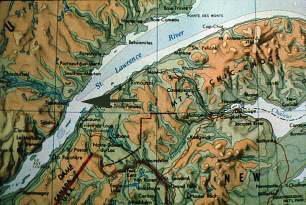Faculté de médecine vétérinaire
Département de biomédecine vétérinaire

 |
Saint Lawrence Belugas ProgramHerd history
|
||||||||||||||||
 |
St Lawrence Estuary, Quebec, Eastern Canada. The habitat of beluga whales is approximately centered on Tadoussac (arrow). The Labrador current flows southwestward in deep water (300 m) in the Laurentien channel in the middle of the Estuary (pale area). This current ends up abruptly at the level of Tadoussac village (arrow) where it surfaces. |
Origin of the St-Lawrence beluga populationMore than 10,000 years ago, most of North America was caving in under the weight of a heavy ice cap covering what is now Canada. The area that is now New York State was nearly completely covered with ice. As the global climate warmed up, the ice cap started to melt, sea levels rose and the Atlantic Ocean invaded the depressed land, reaching westward as far as the Great Lakes, covering New York State and Vermont. This huge body of seawater, called the Champlain Sea, was the southern boundary of what were the Arctic regions of the time. The Sea was inhabited by six species of cetaceans, of which the beluga and the narwhal. As warming continued, the glacier covering the north shore of the Champlain Sea receded northwards. The North American continent raised, relieved from the weight of the ice cap. Because of the higher level of the land, the Atlantic Ocean waters retreated eastward, causing the Champlain Sea to dry up and its outlines to shrink. The habitat of Arctic animals withdrew northwards within its current boundaries.A small population of beluga whales (Delphinapterus leucas) estimated at 650 individuals is all is left from the Arctic fauna of this last glaciation. This population counted 5,000 animals at the beginning of the century. Thus, over 70 years, 90 % of this living record of the biological history of the North American continent disappeared, which earned it the status of endangered population from Government of Canada in 1980. This population now permanently inhabits a marine Arctic microenvironment, which is a short segment of the St. Lawrence Estuary, centered approximately on the mouth of the Saguenay River (see map). Along the north shore of the Estuary, the icy Labrador current flows southwestward 300 meter deep, in the Laurentien channel (cold water is denser than warm water), in a direction that is opposite to that of the surface current. At the level of Tadoussac, a small village of the north shore where the Saguenay river joins the Estuary, the Labrador current hits a huge, almost vertical, underwater wall. There, the depth of the Laurentien channel decreases abruptly from 300 meters to 10 meters (arrow). The icy water of the Labrador currents surfaces and creates a local Arctic marine environment while this upwelling current brings into suspension an enormous amount of organic material from the bottom. This material provides abundant food for plankton, which is eaten by fin whales. (In contrast with beluga whales, fin whales are seasonal visitors: they come only in the summer and early fall to take advantage of the large amounts of food). Plankton is also eaten by dense populations of small fish. In turn, these become the prey of beluga and other marine mammals, including seals. Thus St Lawrence beluga whales are in a way prisoners of this short segment of the Estuary because of these unique ecological conditions and also because of the specialized physiological and morphological adaptations of the species. Nowadays, the Estuary drains one of the most industrialized regions of the world which includes major industrial cities such as Chicago and Detroit, both located on the Great Lakes. Because of this downstream location, the St Lawrence River has been contaminated for decades by industrial effluents. The St Lawrence valley is also a place of extensive agriculture. Herbicides and fertilizers used by modern agriculture also contribute to the pollutant load released in the Estuary. |
|